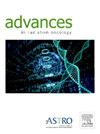复发性恶性胶质瘤质子治疗再照射后的临床结果:来自前瞻性质子协作组注册的分析
IF 2.7
Q3 ONCOLOGY
引用次数: 0
摘要
目的既往放射治疗(RT)后复发胶质瘤的最佳治疗方法尚不明确。质子治疗(PT)越来越多地用于再照射(rt);然而,pt - rt的治疗结果、毒性和预后因素仍然不明确。方法和材料:对2011年7月至2023年12月期间接受pt - rt治疗的恶性胶质瘤患者进行前瞻性、多机构质子协作组注册查询;仅包括至少有一次随访的患者。采用Kaplan-Meier法评估总生存期(OS)和无进展生存期,采用Cox比例风险回归进行单变量和多变量分析(单变量分析和多变量分析)。结果本研究共纳入143例患者,中位随访时间为11.2个月,从先前RT治疗(中位58.5 Gy, IQR, 54-60 Gy)到pt - RT治疗(中位44.6 Gy, IQR, 39.4-55.9 Gy)的中位时间间隔(TI)为42.4个月。中位无进展生存期和OS分别为8.1个月和11.2个月。在单变量分析中,与胶质母细胞瘤相比,改善的OS与少突胶质细胞瘤和星形细胞瘤组织学,TI >;60个月,东部肿瘤合作组表现状态0,rt剂量≥50 Gy相关。在多变量分析中,改善的OS仅与少突胶质细胞瘤和TI相关。急性和晚期3级毒性分别为7%和4%。急性3级毒性与不良的运动状态有关。放射坏死发生率为19%。结论在迄今为止报道的最大的胶质瘤pt - rt系列中,再治疗耐受性良好,基于临床预后因素的结果不同。尽管rrt处方中位剂量较高,但毒性率与基于光子的文献相似。本文章由计算机程序翻译,如有差异,请以英文原文为准。
Clinical Outcomes After Proton Therapy Reirradiation for Recurrent Malignant Glioma: Analysis From the Prospective Proton Collaborative Group Registry
Purpose
Optimal treatment for recurrent glioma after prior radiation therapy (RT) is not well established. Proton therapy (PT) is increasingly used for reirradiation (ReRT); however, treatment outcomes, toxicities, and prognostic factors for PT-ReRT remain poorly defined.
Methods and Materials
The prospective, multi-institutional Proton Collaborative Group registry was queried for patients with malignant glioma who underwent PT-ReRT between July 2011 and December 2023; only patients with at least one follow-up encounter were included. Overall survival (OS) and progression-free survival were assessed using the Kaplan-Meier method, and Cox proportional hazards regression was used for uni- and multivariable analyses (univariable analysis and multivariable analysis).
Results
The study cohort included 143 patients, the median follow-up was 11.2 months, and the median time interval (TI) from prior RT (median 58.5 Gy, IQR, 54-60 Gy) to PT-ReRT (median 44.6 Gy, IQR, 39.4-55.9 Gy) was 42.4 months. Median progression-free survival and OS were 8.1 and 11.2 months, respectively. On univariable analysis, improved OS was associated with oligodendroglioma and astrocytoma histology compared to glioblastoma, TI >60 months, Eastern Cooperative Oncology Group performance status 0, and ReRT dose ≥50 Gy. On multivariable analysis, improved OS remained associated only with oligodendroglioma and TI >60 months. Acute and late grade 3 toxicity occurred in 7% and 4%, respectively. Acute grade 3 toxicity was associated with poor performance status. Incidence of radiographic radiation necrosis was 19%.
Conclusions
In the largest series of glioma PT-ReRT reported to date, retreatment was well tolerated with variable outcomes based on clinical prognostic factors. Toxicity rates were similar compared to photon-based literature despite a high median ReRT prescription dose.
求助全文
通过发布文献求助,成功后即可免费获取论文全文。
去求助
来源期刊

Advances in Radiation Oncology
Medicine-Radiology, Nuclear Medicine and Imaging
CiteScore
4.60
自引率
4.30%
发文量
208
审稿时长
98 days
期刊介绍:
The purpose of Advances is to provide information for clinicians who use radiation therapy by publishing: Clinical trial reports and reanalyses. Basic science original reports. Manuscripts examining health services research, comparative and cost effectiveness research, and systematic reviews. Case reports documenting unusual problems and solutions. High quality multi and single institutional series, as well as other novel retrospective hypothesis generating series. Timely critical reviews on important topics in radiation oncology, such as side effects. Articles reporting the natural history of disease and patterns of failure, particularly as they relate to treatment volume delineation. Articles on safety and quality in radiation therapy. Essays on clinical experience. Articles on practice transformation in radiation oncology, in particular: Aspects of health policy that may impact the future practice of radiation oncology. How information technology, such as data analytics and systems innovations, will change radiation oncology practice. Articles on imaging as they relate to radiation therapy treatment.
 求助内容:
求助内容: 应助结果提醒方式:
应助结果提醒方式:


